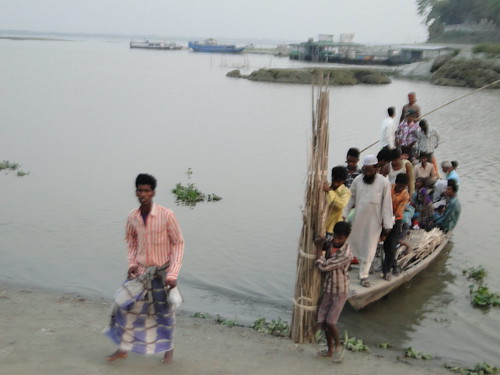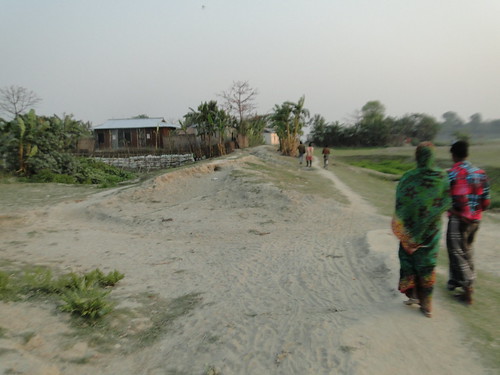Part II of the two parts articles on recent trip to Dhubri in Assam. Read Part One here.
Maati nei, Ghar nei, Swaami nei (No land, no house, husband no more…) was the common rhetoric women folks in villages narrated.
By M. Reyaz, TwoCircles.net,
Our next stop was Kuntisar village, a char or river basin across the river Brahmaputra, near Dhubri town.
Not that the villages I visited before, near Bilasipara had what we could call basic infrastructure – Prime Minster Graam Sadak yoojna hardly had any trace here, no health centre, hardly any schools, no regular source of income. I was already losing hope.
But as we reached the Historic Netai Dhubuni Ghat at Dhubri, and could see a glimpse of Kuntisar village across a narrow stream of the river, we realized that the worst is yet to come. On the other side of the river was no scenic beauty, no splendid resorts, no villas, no tourists dotting, but even poorer, more depilated houses, dusty pathways was waiting to welcome us.

Historic Netai Dhubuni Ghat at Dhubri
Boat – or launch, steamer in bigger places - is the only method of commutation to these chars. In chars separated by smaller streams, sometimes you would find bridges constructed often wooden, implying little government support. From bicycle, to goats, to all essentials, children returning from school, woman with her sick mother in law, men returning tired from their long day toil, were all on the boat.
To our pleasant surprise many things were still very cheap in this part of the forlorn world. The ferry charge was two rupees.

A ferry across the stream of river cost an individual Rs 2 and is the only mean of communication with the world.
The first house we entered had a courtyard, with hearth on one side and a hall size room on the other. We found two young women – Halima and Soneka - and several children. When we ask if they face any problem in the house, younger looking Soneka replies in Bengali, “What problem, nothing as such.”
For people living in such poverty, two squares meal a day is all most hope for, anything and everything above is luxury. However, probe them little more and they tell you about everyday travails.

Halima and Soneka are married to same man, a mason. What struck me was they have accepted everything to be their fate and have hardly any aspiration for better future.
During our conversation, elder looking Halima says, “It would have been better if we had bigger house, with at least two rooms….” and fumbles. It is then that we realize that both the women were married to same man, a mason.
There is not a single health centre in this village comprising of over 220 houses, with a population of over 1300. From school, to work to medication, they are dependent on Dhubri town.
During monsoon, they tell us, they face enormous problems, when there is incessant rain and river is brimming above normal level. “It’s like you are cut off from everything,” they tell you.
Thinking we would be able to help them they surround us and narrate their problems. ”Maati nei, Ghar nei, Swaami nei (No land, no house, husband no more…) was the common rhetoric many women in these villages narrated. We met several widows. Due to extreme poverty, poor unhygienic conditions, lack of proper health system mortality rate is expected to be high.
While the men could take another wife, it was not as easy for women to re-marry. The name of most women would tell about their marital status. Some Biwi or Khatoon for married women, however, word Bewa (widow) is suffixed to first name in the name of those women, whose husbands have died.

An outsider “surveying” gives them new hopes that things might get better.
Besides working in fields and breeding cattle, some work in Agarbatti or joss sticks making factory, or went to the town to do odd manual jobs.
Lone Aganwadi – ray of hope
Lone Aganwadi in Kuntisar Char was the only ray of hope in this village. 25 year old Shahida Khatoon, who works as the Anganwadi worker tells us that about 40 small children come here every day and study basics. They also get mid-day meal she informs us.

Aganwadi worker Shahida with some of the children outside the center.
Shahida has herself passed matriculation. “As children grow and learn basics, we enroll them to the school in the town, where they go by boat every day,” she says. She hoped that there would be a school in future in the village.
Apathy of administration and politicians :
It has generally been easy for Muslim politicians, particularly those representing the Bengali speaking populace, to blame the regional politics, anti-Muslim and anti-Bengali stand of Assamese leaders for the backwardness of the Muslim dominated regions.

The main road of Kuntisar village, a Char across Dhubri town, from the river bank.
Dhubri is a stronghold of All India United Democratic Front (AIUDF) and even in town we do not see any significant developmental projects. AIUDF largely cash on the ‘security’ factor of these Bengali speaking Muslims, who are seen with suspicion as foreigners who have ‘illegally’ migrated here.
When asked about NREGA, job cards, or other such welfare schemes, most claim that they do not know much about them. About job cards and BPL families, they say local politicians and village leaders generally ask for money and that most facilities go into their homes.

Television, big sound box and mobile phones have reached this forlorn village though, although there is no electricity. A local boy tells me to charge the mobile phone they cross the river and pay five rupees each time in town. Hopefully with ‘modern’ gadgets demand for development will also rise.
Related:
From where have all the ‘Bangaldeshis’ come? A brief history of Muslims in Assam